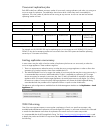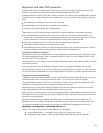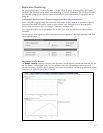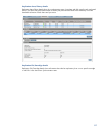62
2. At each remote site perform a full system backup to the source D2D and then configure a 1:1
mapping relationship with the floating D2D device” e.g. SVTL1 on Remote Site A - FTVTL1 on
floating D2D. FTVTL1 = floating target VTL1.
3. Seeding remote site A to the floating D2D will take place over the GbE link and may take several
hours.
4. On the Source D2D at the remote site DELETE the replication mappings – this effectively isolates
the data that is now on the floating D2D.
5. Repeat the process steps 1-4 at Remote sites B and C.
6. When the floating D2D arrives at the central site, the floating D2D effectively becomes the Source
device to replicate INTO the D2D unit at the data center site.
7. On the Floating D2D we will have devices (previously named as FTVTL1, FTNASshare 1) that we
can see from the Web Management Interface. Using the same master naming convention as we did
in step 1, set up replication which will necessitate the creation of the necessary devices (VTL or
NAS) on the D2D4100 at the Data Center site e.g. TVTL1, TNASshare 1.
8. This time when replication starts up the contents of the floating D2D will be replicated to the data
center D2D over the GbE connection at the data center site and will take several hours. In this
example Remote Site A, B, C data will be replicated and seeded into the D2D4100. When this
replication step is complete, DELETE the replication mappings on the floating D2D, to isolate the
data on the floating D2D and then DELETE the actual devices on the floating D2D, so the device is
ready for the next batch of remote sites.
9. Repeat steps 1-8 for the next series of remote sites until all the remote site data has been seeded
into the D2D4100.
10. Now we have to set up the final replication mappings using our agreed naming convention
decided in Step 1. This time we go to the Remote sites and configure replication again to the Data
Center site but being careful to use the agreed naming convention at the data center site e.g.
TVTL1, TNASshare1 etc.
This time when we set up replication the D2D4100 at the target site presents a list of possible
target replication devices available to the remote site A. So in this example we would select TVTL1
or TNASshare1 from the drop-down list presented to Remote Site A when we are configuring the
final replication mappings. This time when the replication starts almost all the necessary data is
already seeded on the D2D4100 for Remote site A and the synchronization process happens very
quickly.


















